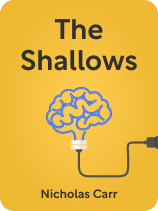

This article is an excerpt from the Shortform book guide to "The Shallows" by Nicholas Carr. Shortform has the world's best summaries and analyses of books you should be reading.
Like this article? Sign up for a free trial here.
Is the internet changing the way we read? How does online reading affect our ability to concentrate?
Internet reading has transformed our habits and cognitive processes. Nicholas Carr explores this shift in his book The Shallows. He examines how deep reading, once encouraged by printed books, is being replaced by skimming and shallow engagement online.
Read more to get Carr’s insights and discover how our digital habits are reshaping our minds and media consumption.
The Effects of Internet Reading
Carr argues that the internet’s instant rewards have hampered the practice of deep reading that printed books encourage. There’s an ongoing battle between deep and shallow reading—immersive engagement versus skimming—with evidence suggesting that internet reading promotes the latter. The evolution of the written word has introduced us to deep concentration and enhanced our abstract thinking skills, but the shift toward skimming information online is reshaping not just our reading habits but also our media consumption as a whole.
While this might sound like a dire warning, Carr points out that new information media don’t completely supplant whatever came before. When the written word was invented, it didn’t replace oral culture—instead, it added another layer to our communication methods. Silent reading wasn’t common, Carr says, until written languages developed features such as word breaks and punctuation to make reading easier. Once this happened, reading reshaped our brains to focus deeply on a single task, in contrast to our inherent nature of being easily distracted. Because of this, reading books not only improved our concentration but also enhanced our abstract thinking skills.
(Shortform note: Beyond the benefits Carr lists above, research shows that reading rewires the brain in a way that builds empathy, understanding, and broader perspectives on complex ideas. For instance, reading fiction triggers a mirroring effect in the brain in which readers empathize with characters and even simulate their actions and feelings. Because we can’t affect the outcome of the story we’re reading, our brains don’t engage the neural processes that would spur us to doubt the story in question. Instead, they respond as if the fictional story we’re reading is true, letting us practice new emotional states and experience points of view that our brains can’t access in our day-to-day lives.)
However, Carr makes a distinction between “deep” and “shallow” reading. While deep reading involves immersive engagement, shallow reading is used in tasks like skimming an index or reading street signs. Evidence suggests that internet use promotes skimming text over deep reading, even when we interact with printed text offline. While browsing online content, our eyes hunt around for relevant bits of information instead of following every line of text. Research shows that this “skimming” eye movement pattern is becoming dominant among readers largely because of extensive internet usage, whereas in pre-internet times it was only a peripheral skill used on occasion depending on need.
(Shortform note: Like it or not, the habitual skimming that Carr decries may be here to stay, and authors may have to adapt their writing style to connect with a modern audience. In Writing for Busy Readers, Todd Rogers and Jessica Lasky-Fink suggest that today’s authors should prioritize brevity, clarity, and relevance, breaking down complex ideas into concise language and short paragraphs. They should also clearly label sections of text to help readers quickly find the content they need. Additionally, presenting the most important points first helps busy readers grasp the general points even if they don’t read the whole article or book. In other words, modern authors have a choice between clear, punchy writing and losing their readers’ attention.)
Carr describes how the shift from concentrated reading to skimming has altered the media landscape as a whole. While internet use has actually increased the amount of time we spend reading every day, that reading is now largely in the “shallow” category. Traditional publishers now tailor their content to presentation styles similar to what people experience online, either by inserting hyperlinks into e-books or by trimming lengthy news articles down to more rapidly consumable chunks. What the internet hasn’t impacted is TV time, which means that it’s increased our daily screen time at the cost of printed books, magazines, and newspapers.
(Shortform note: The creeping intrusion of internet-style content into print publishing hasn’t been as sweeping as Carr originally predicted. For example, even at the time of Carr’s writing, publishers were aware that inserting hyperlinks into e-books was both distracting and detrimental to whatever point an author wanted to make. Also, over a decade after publication of The Shallows, print books remain more popular than e-books, even among younger demographics. However, the time we spend looking at screens increases every year, with six and a half hours per day the global average as of 2023—though for US teens, the average shoots up to nine hours per day, most of which is dedicated to looking at mobile devices.)
Exercise
When you come across an article online, how often do you read it all, and how often do you skim it for just the main points? When you come across a similar article from a print source, do you read it in a different way? Why or why not?

———End of Preview———
Like what you just read? Read the rest of the world's best book summary and analysis of Nicholas Carr's "The Shallows" at Shortform.
Here's what you'll find in our full The Shallows summary:
- The ways internet use is literally reconfiguring our brains
- How information technologies reshape human behavior
- The sweeping societal consequences of these changes in human cognition






